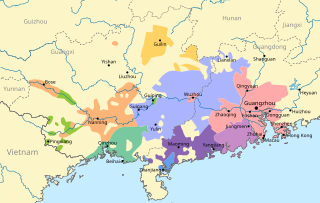Qin–Lian Yue
| Qin-Lian Yue | |
|---|---|
| Hamlim Yuht | |
| Native to | China |
| Region | Guangxi |
Native speakers | About 3,900,000 (2013)[1] |
| Language codes | |
| ISO 639-3 | – |
| ISO 639-6 | qnli |
| Glottolog | qinl1235 |
| Linguasphere | 79-AAA-mf |
 Qin-Lian (lower left), among other Yue and Pinghua groups in Guangxi and Guangdong | |
Qin–Lian (Hamlim, 欽廉方言) is a southern branch of Yue Chinese spoken in the coastal part of Guangxi, which is represented by four traditional cities Qinzhou, Lianzhou, Lingshan and Fangcheng ("欽廉靈防") or by three modern prefecture-level cities Qinzhou, Beihai and Fangcheng ("欽北防").
Criterion
Middle Chinese had a series of voiced initials, but voicing has been lost throughout Yue and most other modern Chinese varieties apart from Wu and Old Xiang. The reflexes of the voiced stops and affricates are often used to classify Chinese varieties.
In most Qin–Lian varieties, these consonants develop into aspirates in all tones, a pattern also found in Wu–Hua Yue and Hakka,[2][3] which is also the traditional criterion of Qin-Lian Yue. However, in urban Qin–Lian varieties they yield aspirates in the level and rising tones, and non-aspirates in the departing and entering tones,[2] the same pattern found in the Guangfu, Siyi and Gao-Yang branches of Yue.[3]
Subgrouping
There are several branches of Qin-Lian.
Urban varieties
Urban varieties, informally called "plain speech" (s白话; t白話),[4] are spoken in the cities of Qinzhou (Hamzau), Beihai (Bakhoi), Fangcheng (Pongsing), Dongxing (Dunghing) and Lingcheng (Lingsing) and some nearby towns.[5] They are close to Standard Cantonese,[6] with the same consonant shifting pattern, and only partly mutually intelligible with other Qin-Lian Yue varieties.
In spite of distinguishable but tiny differences on phonology and vocabulary, there is high mutual intelligibility and a great number of common colloquial words in the urban varieties and furthermore, in some varieties of Yong-Xun and Gao-Yang. Those features along with its scattered speaking zones may reflect the influence of intercity commercial communication in history, and lead to a lasting debate on its classification.[2]
The table below shows the differences in phonology among four major urban varieties.
| Qinzhou | Fangcheng | Lingshan | Beihai | |
|---|---|---|---|---|
| vowel breaking of "i" | no | no | often | yes |
| "ou" > "au" merger | yes | yes | no | yes |
| "oe" > "e" merger | younger speakers | no | yes | yes |
| "i" > "z" shifting | no | no | no | younger speakers |
| terminal consonants merger | no | no | no | younger speakers |
Lianzhou
Lianzhou (Limzau) varieties, also called hoi caat waa (海獺話, "the tongue of the sea otters") and maa lau waa(麻佬話, "the tongue of people in sackcloth"), are spoken in Hepu(Lianzhou as the center city), in the southern part of Pubei and in the coastal areas of Qinzhou and Fangchenggang.[5] This branch, represented by the Lianzhou variety, is considered a Pinghua-based Yue dialect with some Hakka and Min blended in.[2]
There are some differences with urban varieties that may confuse urban speakers at first. For example, the "-ing" is generally pronounced like "-an", and the "yu", which is replaced by "i" in urban varieties, appears to be "u" in Lianzhou.[2] As a result, 停 ("to stop", "ting4" in urban varieties, "tan3" in Lianzhao) can be mistaken as 褪 ("to move backwards", "tan3" in urban varieties).
Lingshan
Lingshan (Lingsaan) varieties are widely spoken in the countryside of Qinzhou, Lingshan and Pubei.[5]
Xiaojiang
Xiaojiang (Sliugong) varieties are spoken in Pubei.[5]
References
- ^ Huang, Qiye 黄绮烨 (2013). Guǎngxī Fángchénggǎng yuèyǔ yǔyīn yánjiū 广西防城港粤语语音研究 [A phonetic study of Cantonese in Fangchenggang, Guangxi] (M.A. thesis). Jinan University.
{{cite thesis}}: Invalid|script-title=: missing prefix (help) - ^ a b c d e Lu, Bo 陆波 (2006). Guǎngxī Qīnzhōu Qīnlián piàn fāngyán yīnyùn yánjiū 广西钦州钦廉片方言音韵研究 [Study on the phonology of Qinlian dialect in Qinzhou of Guangxi] (M.A. thesis). Guangxi University.
{{cite thesis}}: Invalid|script-title=: missing prefix (help) - ^ a b Yan, Margaret Mian (2006). Introduction to Chinese Dialectology. LINCOM Europa. p. 193. ISBN 978-3-89586-629-6.
- ^ Jyutping: baak waa
- ^ a b c d Liang, Yougang 梁猷刚 (1986). "Guǎngxī Qīnzhōu dìqū de yǔyán fēnbù" 广西钦州地区的语言分布 [Guangxi Qinzhou dialect area]. Fangyan (3): 219–222.
{{cite journal}}: Invalid|script-title=: missing prefix (help) - ^ de Sousa, Hilário (2016). "Language contact in Nanning: Nanning Pinghua and Nanning Cantonese". In Chappell, Hilary M. (ed.). Diversity in Sinitic Languages. Oxford University Press. pp. 157–189. ISBN 978-0-19-872379-0. p. 162.
